The Selma to Montgomery National Historic Trail in Alabama memorializes the route taken by marchers during the Voting Rights March from March 21 to March 25, 1965. This complete guide includes history, things to do and see, nearby lodging and camping, tours, directions, and so much more.
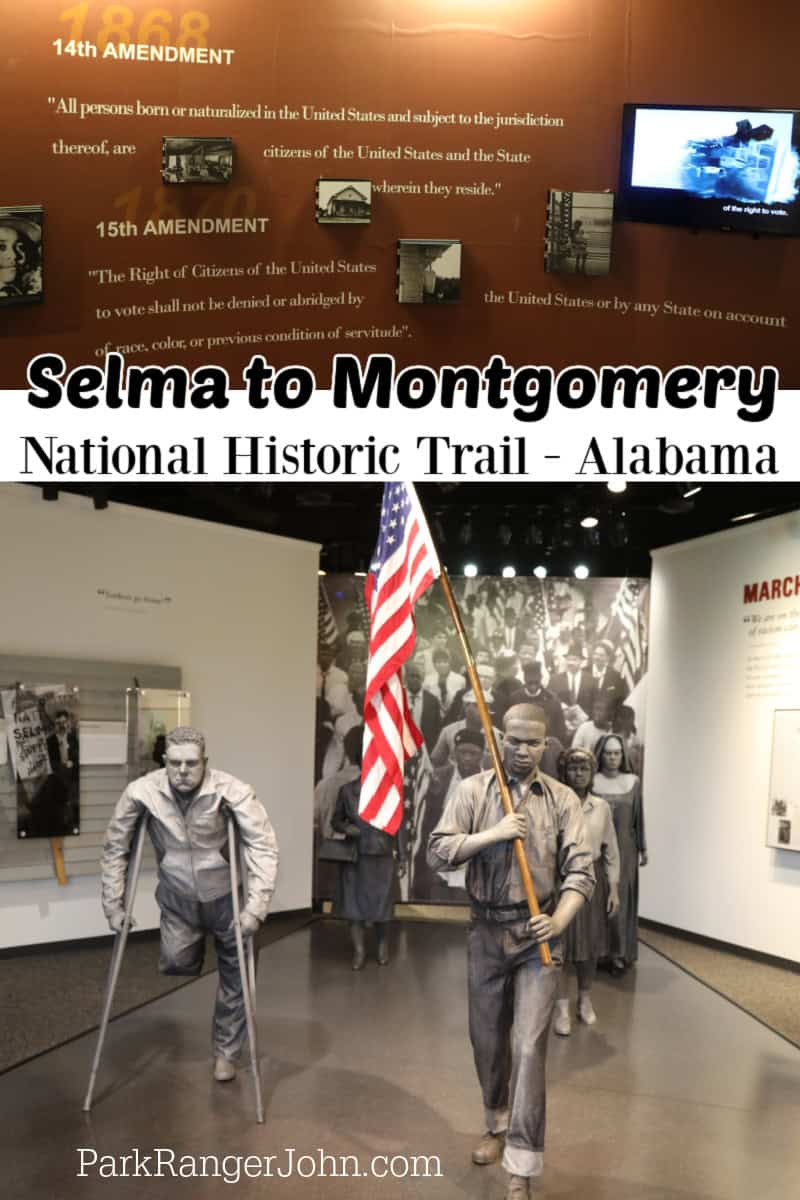
Selma to Montgomery National Historic Trail
The Selma Marches were a series of protests that took place in March of 1965 in Selma Alabama. The protests were against Jim Crow Laws, laws that were passed in several southern states to get around the Fifteenth Amendment of the US Constitution (the right for Black men the right to vote) that was ratified on 2/3/1870 after the end of the U.S. Civil War which took place from April 12, 1861, to May 26, 1865.
About Selma to Montgomery NHT
This march was a huge event in the civil rights movement which eventually leads to the passage of the 1965 Voting Rights Act.
3,000 people assembled in Selma, Alabama on March 21st to march on foot to the state capital in Montgomery 54 miles away.
Dr. Martin Luther King addressed the crowd at a concluding rally near the state capitol giving his famed " How long, Not long" speech. (see video below)
The 54-mile march was not easy and on March 7, 1965, now known as "Bloody Sunday" marches ran into police on the outskirts of Selma. The police attacked peaceful marchers with clubs and tear gas.
These events sent shockwaves through the world and convinced political leaders the time had come for voting rights legislation.
You can travel along the Selma to Montgomery March route to see the route taken by marches, see where the tent camps were set up, and learn about what went into this civil rights movement.
Is Selma to Montgomery NHT worth visiting?
I have to tell you that this site hit me hard! I walked around in awe that humans can treat other humans so horribly and that it happened only a little over 50 years ago.
This is a site everyone should visit to learn about what people went through to get voting rights. It is hard to hear people talk about not voting in today's elections after you hear about US citizens being hit with cattle prods while trying to march for voting rights.
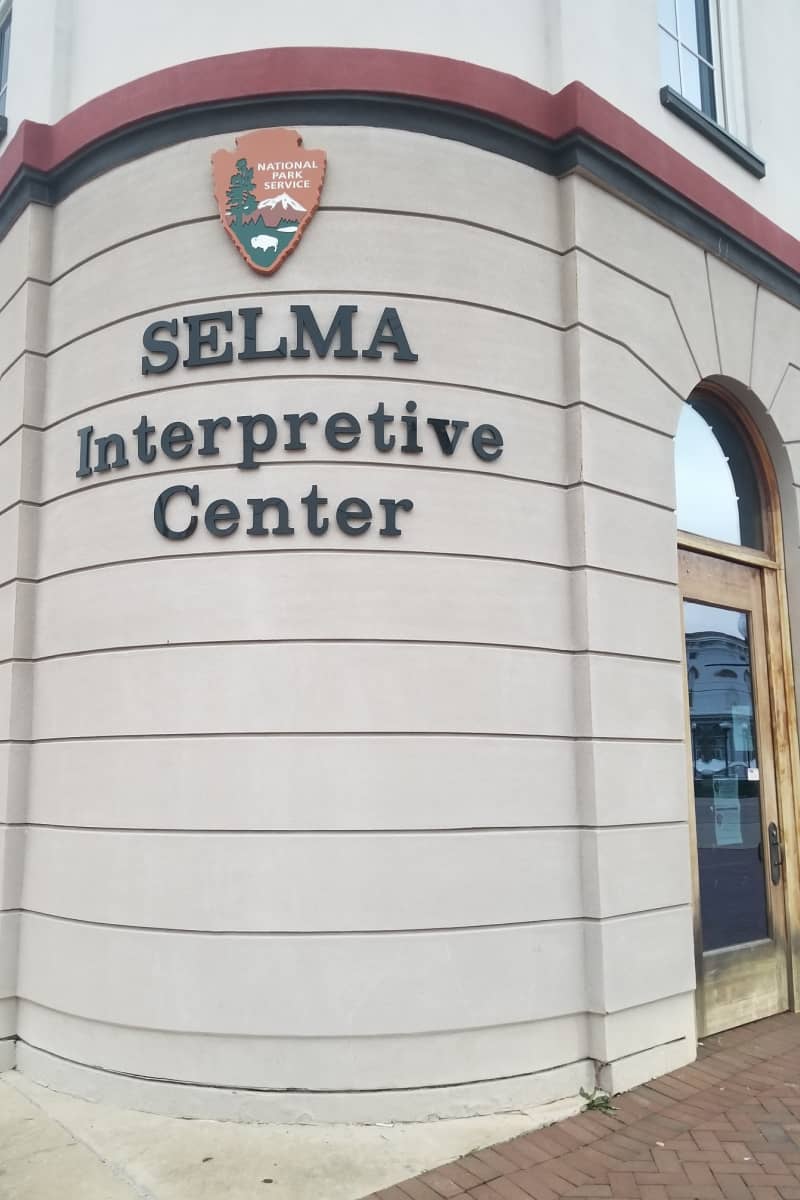
History of Selma to Montgomery NHT
Established in 1996, Selma to Montgomery National Historic Trail is a 54-mile trail that begins at the Brown Chapel African Methodist Episcopal Church in Selma, Alabama, and ends in Montgomery, Alabama.
The route follows the historic route of the 1965 march of black and white non-violent supporters led by Dr. Martin Luther King Jr.; bringing awareness to voting rights.
Passed on July 2, the Civil Rights Act of 1964 was a “federal law that prohibited discrimination on the basis of race, color, or national origin in all programs or activities receiving federal funding.”
After this act was passed, civil rights groups attempted to register black voters but were in turn met with dangerous hostility in southern states, particularly Alabama.
Dr. Martin Luther King Jr., having just won the Nobel Peace Prize that year, chose Selma as the epicenter of his black voters’ campaign. The County Sheriff, along with Governor George Wallace, strongly opposed desegregation; and consequently, only around 2 percent of Selma’s black voters were able to register.
1965 brought rising tensions for the black community in Alabama fighting for voting rights. On the evening of February 18, 1965, a group of activists gathered at the Zion United Methodist Church in Marion, Alabama in support of an activist named James Orange, who had just been arrested.
Alabama State Troopers arrived at the peaceful demonstration and began attacking the crowd. Jimmie Lee Jackson, his mother, and his 82-year-old grandfather were chased into a nearby Café where they were beaten.
When Jackson came to the aid of his mother and grandfather he was shot twice by trooper James Fowler. Jackson collapsed outside the Café and passed away eight days later due to the gunshot wounds.
On March 7, 1965, a group of 600 people, led by King, gathered in response to Jackson’s death. Their goal was to march from Selma to the state capital – Montgomery. After only a few miles, the group was met by troopers on the Edmund Pettis Bridge and pushed and beaten back to Selma. This day was known as Bloody Sunday of 1965.
On March 9 King now had over 2,000 marchers, having been joined by hundreds of ministers, priests, and protestors – black and white.
The group made it past the bridge this time, but troopers were then blocking Highway 80. King began to lead the group in prayer at which time the troopers allowed them through.
But that night segregationists attacked again and this time killed a minister named James Reeb. Wallace and other Alabama state officials tried to halt the march but the nation was already watching.
On March 15th, President Lyndon Johnson gave a nationally televised speech giving his support to the Selma marchers.
The Selma marchers began again on March 21, and with the support of President Johnson, protected by the U.S. Army and Alabama National Guard.
Nearly 25,000 marchers were supported by the Southern Christian Leadership Conference and the Students Nonviolent Coordinating Committee which coordinated food, camping, and sanitation for the marchers to Montgomery.
Once they arrived at the capital, the marchers found the support of over 50,000 people, both black and white. After four days and nights, the marchers arrived in Montgomery on March 25th.
Today’s national trail follows this historic march and points to locations along the way that were important during those four days.
One such location is St. Jude’s Historic District which includes a church and hospital. On the last night of the march, St. Jude offered 36 acres of athletic fields for marchers to camp on.
Celebrities including Harry Belafonte, Tony Bennett, and Peter, Paul, and Mary performed for the marchers.
Another location marks the place where a white mother and housewife was murdered by Ku Klux Klan members while ferrying marchers with her car. Hospital staff at nearby St. Jude’s tried desperately to save her life.
That August, the Voting Rights Act of 1965, which guaranteed equal voting rights to all African Americans, was passed.
This Act was one of the biggest events in the Civil Rights Movement led by brave African Americans and supportive Americans all over the nation.
The National Historic Trail preserves the memory of this iconic four-day event in history. In both 2015 and 2020, to celebrate the 50th and 55th anniversaries respectively, cyclists from all over the country traveled the route on the National Historic Trail.
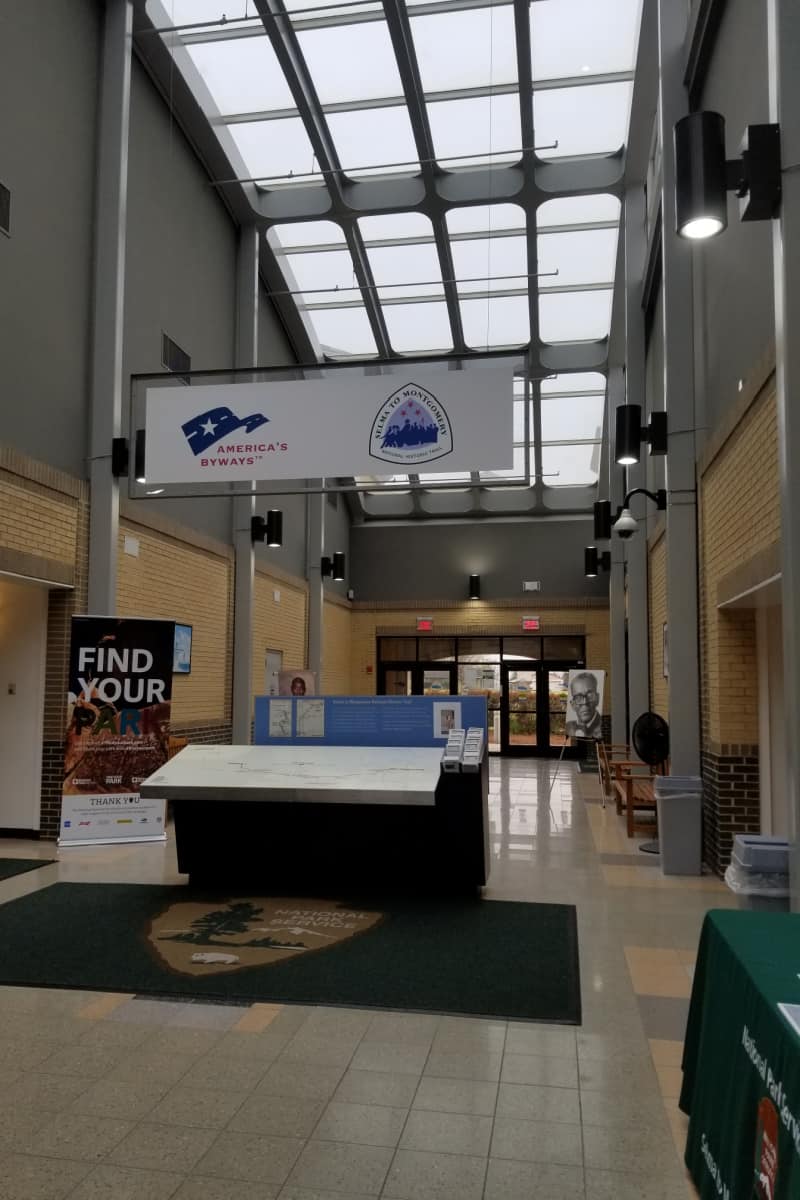
Things to know before your visit to Selma to Montgomery NHT
Selma to Montgomery National Historic Trail Entrance Fee
Park entrance fees are separate from camping and lodging fees.
Selma to Montgomery National Historic Trail does not charge an entrance fee!
Learn more about National Park Passes for parks that have an entrance fee.
$80.00 - For the America the Beautiful/National Park Pass. The pass covers entrance fees to all US National Park Sites and over 2,000 Federal Recreation Fee Sites for an entire year and covers everyone in the car for per-vehicle sites and up to 4 adults for per-person sites.

Buy your pass at this link, and REI will donate 10% of pass proceeds to the National Forest Foundation, National Park Foundation, and the U.S. Endowment for Forestry & Communities.
National Park Free Entrance Days -Mark your calendars with the five free entrance days the National Park Service offers annually.
Time Zone
Central Time Zone
Pets
Pets are allowed along the trail but not within visitor centers and historic buildings.
Cell Service
We had pretty good cell service during our visit. There were a few areas with spotty coverage.
Park Hours
All three visitor centers, the Lowndes, Montgomery, and Selma Interpretive Centers are open from Wednesdays - Saturdays.
Wi-Fi
Public Wi-Fi is not available at this time.
Parking
The Lowndes Interpretive Center has a large parking lot with a ton of space.
Food/Restaurants
There are many restaurants in Montgomery and Selma, Alabama
Gas
There are multiple gas stations that are easy to reach.
Drones
Drones are not permitted within National Park Sites.
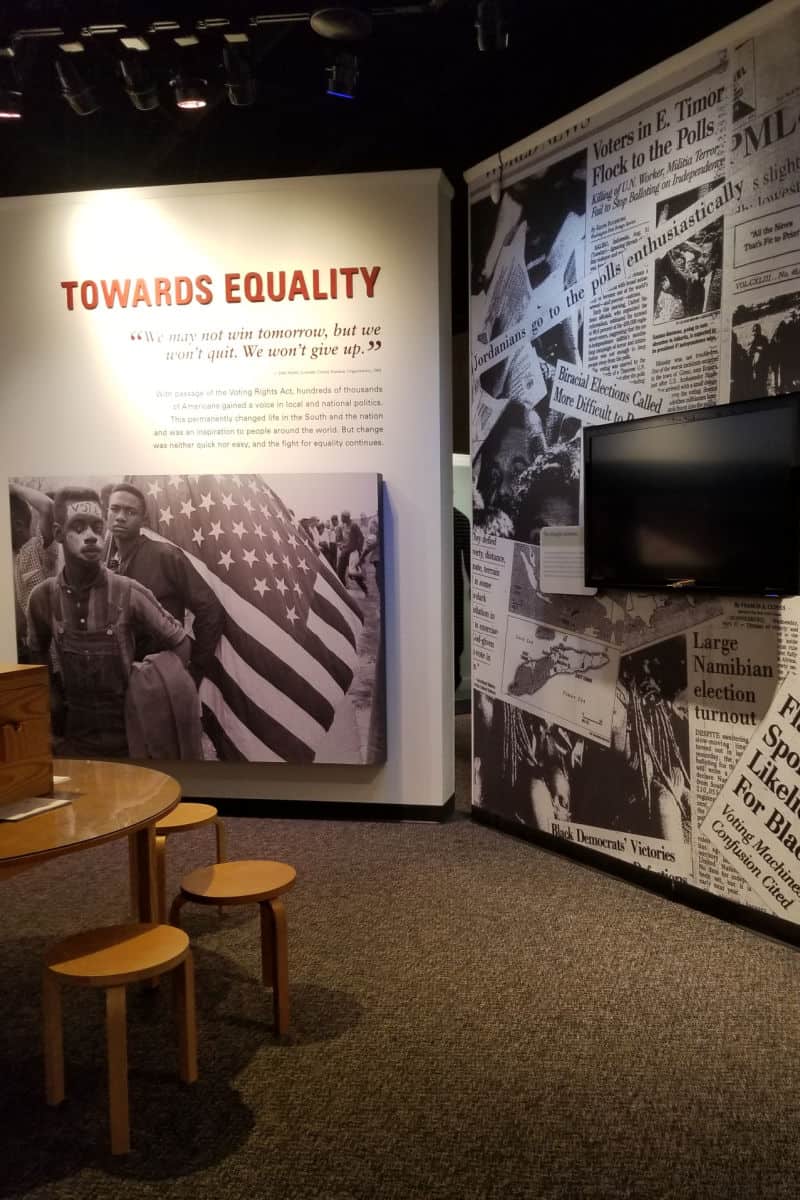
Electric Vehicle Charging
There are 8 EV charging stations within 30 miles of Selma, Alabama.
There are 84 public charging stations (some are free) in Montgomery, Alabama.
Don't forget to pack
Don't forget to pack
Insect repellent is always a great idea outdoors, especially around any body of water.
We use Permethrin Spray on our clothes before our park trips. Please read my article on preventing biting insects while enjoying the outdoors.
Sunscreen - I buy environmentally friendly sunscreen whenever possible because you inevitably pull it out at the beach.
Bring your water bottle and plenty of water with you. Plastic water bottles are not sold in the park.
Sunglasses - I always bring sunglasses with me. I personally love Goodr sunglasses because they are lightweight, durable, and have awesome National Park Designs from several National Parks like Joshua Tree, Yellowstone, Hawaii Volcanoes, Acadia, Denali, and more!
Click here to get your National Parks Edition of Goodr Sunglasses!
Binoculars/Spotting Scope - These will help spot birds and wildlife and make them easier to identify. We tend to see waterfowl in the distance, and they are always just a bit too far to identify them without binoculars.
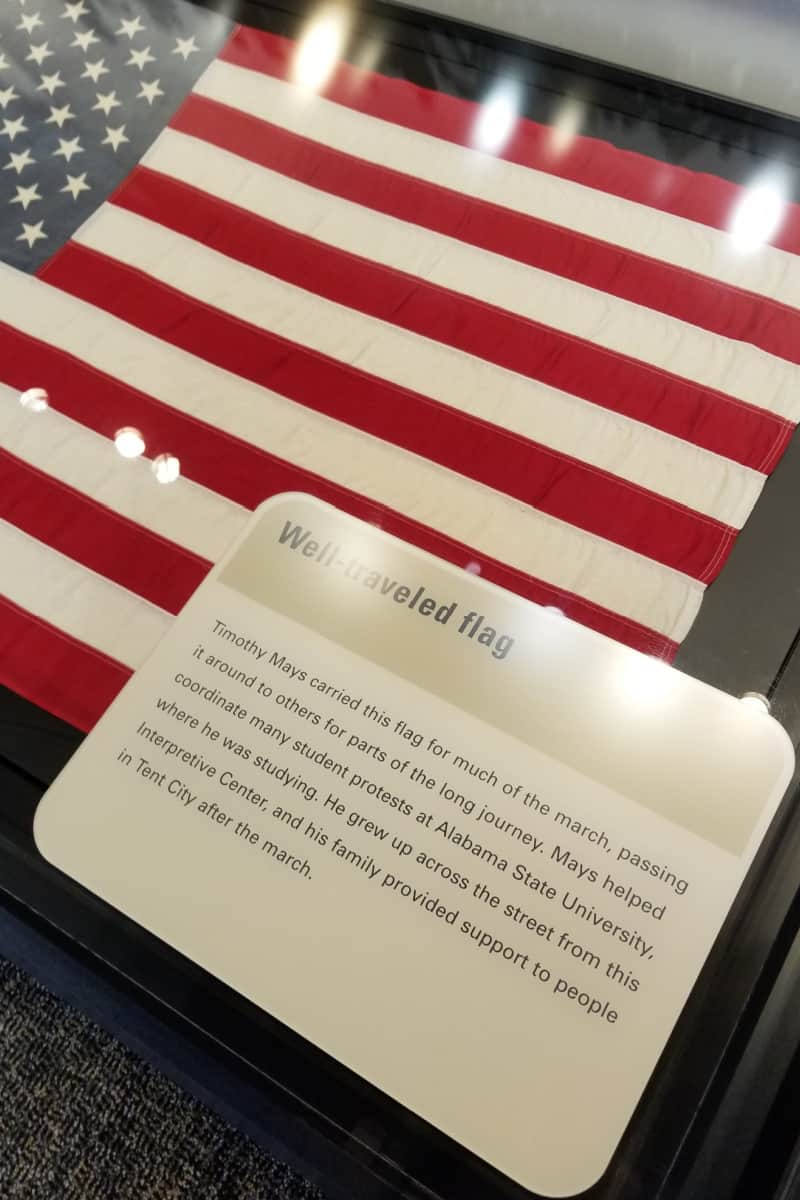
Details about Selma to Montgomery NHT
Size - the 54-mile path between Selma and Montgomery, Alabama
Check out how the park compares to other National Parks by Size.
Date Established
1996 - Congress established the Selma to Montgomery National Historic Trail to commemorate the events, people, and route of the 1965 Voting Rights March in Alabama.
Visitation
Learn more about the most visited and least visited National Parks in the US
National Park Address
Lowndes Interpretive Center, U.S. 80, Hayneville, AL, USA
Selma Interpretive Center, 2 Broad Street, Selma, AL 36701, USA
Montgomery Interpretive Canter - On the campus of Alabama State University.
National Park Map
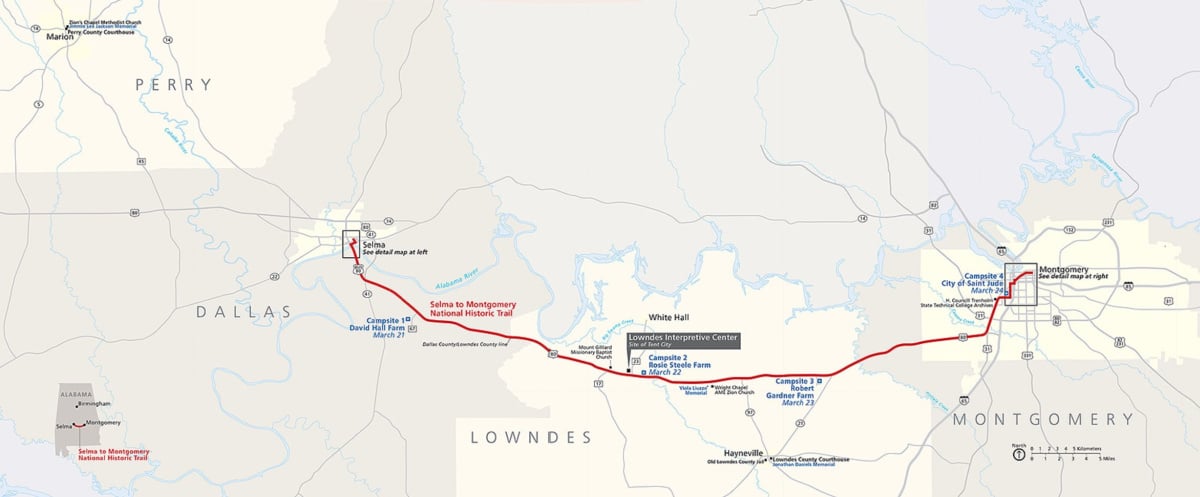
Where is Selma to Montgomery NHT?
Selma to Montgomery National Historic Trail (NHT) is located in the state of Alabama, United States.
The historic trail passes through several points of interest related to the Civil Rights Movement including the Edmund Pettus Bridge in Selma and the Alabama State Capitol building in Montgomery.
Estimated distance from major cities nearby
Tuscaloosa, AL - 78 Miles
Birmingham, AL - 92 Miles
Mobile, AL - 173 Miles
Columbus, GA - 138 Miles
Atlanta, GA - 210 Miles
Nashville, TN - 283 Miles
Memphis, TN - 305 Miles
New Orleans, LA - 302 Miles
Louisville, KY - 457 Miles
Charlotte, NC - 455 Miles
Estimated Distance from nearby National Park
Great Smoky Mountains National Park - 385 Miles
Mammoth Cave National Park - 374 Miles
Shenandoah National Park - 754 Miles
Hot Springs National Park - 496 Miles
Congaree National Park - 434 Miles
Everglades National Park - 771 Miles
Where is the National Park Visitor Center?
Selma to Montgomery Visitor Center
2 Broad St.
Selma, Al. 36701
Getting to Selma to Montgomery NHT
Closest Airports
Montgomery Regional Airport (MGM)
International Airports
Birmingham Shuttlesworth International Airport (BHM)
Hartsfield Jackson Atlanta Airport (ATL)
Driving Directions
The National Historic Trail follows the actual march route which began at Brown Chapel, A.M.E. Church in Selma, AL, located on Martin Luther King, Jr. Street.
Follow the Trail markers to U.S. Hwy. 80 through Lowndes County, AL. Continue on U.S. Hwy. 80 to Montgomery concluding at the Alabama State Capitol in Montgomery, AL, located on Dexter Avenue.
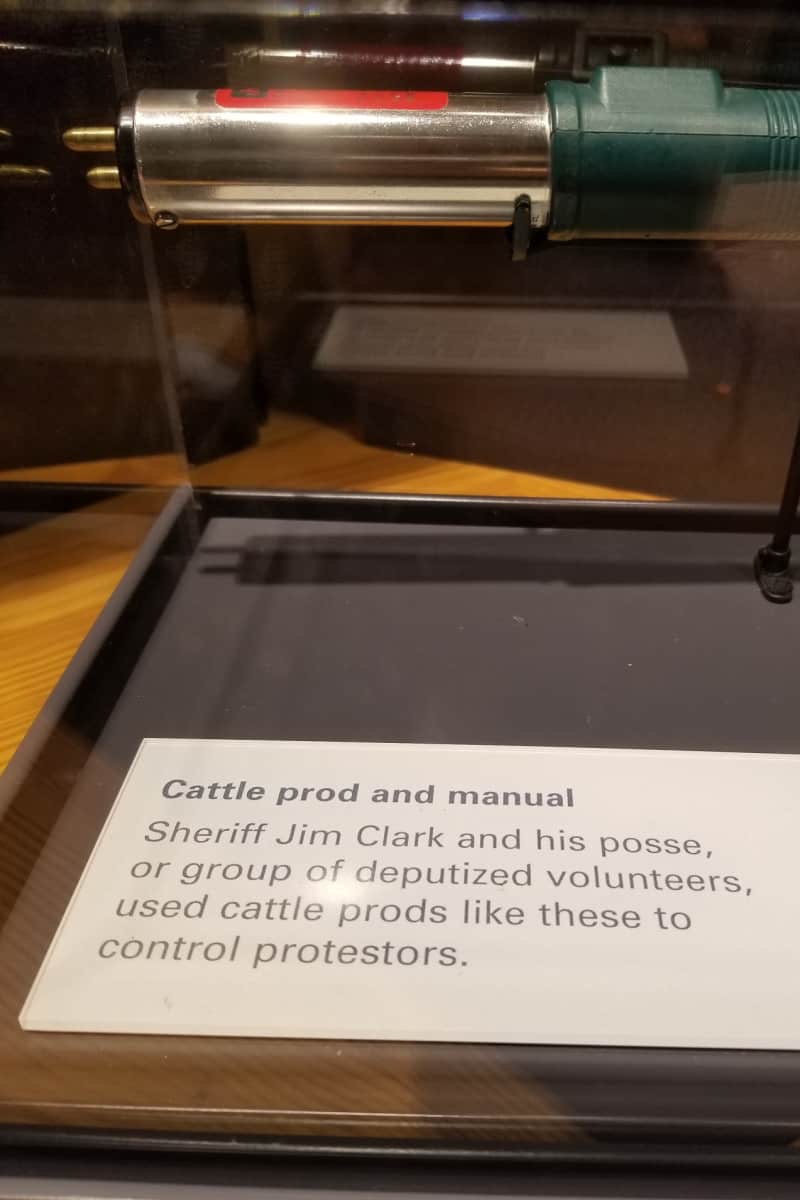
Best time to visit Selma to Montgomery NHT
While the trail is open year-round we find that the best time of year to visit is Spring and Fall when the weather is milder.
The spring is also a popular time to visit due to the annual reenactment of the Selma to Montgomery March, which takes place in late March.
Weather and Seasons
Summers can become very hot and humid so make sure to drink plenty of water, use sunscreen, and wear light clothes and comfortable shoes.
Winters tend to be cold and damp so it is important to wear layers and bring extra clothing in case the weather changes.
Best Things to do in Selma to Montgomery NHT
Selma to Montgomery National Historic Trail Interpretive Centers
Selma Interpretive Center
The Selma Interpretive Center is located across from the Edmund Pettus Bridge. The center has a bookstore, and interpretive programs and serves as a welcome center with staff available to answer your questions.
Lowndes Interpretive Center
Located midway between Selma and Montgomery in White Hall, Alabama the Lowndes Interpretive Center is a large visitor center with amazing interpretive exhibits.
Plan to spend a minimum of an hour learning more about the Selma to Montgomery March. I would plan a couple of hours if you can to truly absorb all of the exhibits and watch the park 25-minute film titled, "Never Lose Sight of Freedom".
Make sure to check out the ceiling in the entryway that looks like the Edmund Pettus Bridge.
The interpretive displays at the Lowndes Interpretive Center are honestly amazing!
2025 Selma to Montgomery Bridge Crossing Jubilee
March 6-9, 2025, Selma, Alabama, will celebrate the 60th anniversary of "Bloody Sunday," which led to the passage of the Voting Rights Act of 1965. This is the world's largest Civil Rights commemoration where current and past Presidents and hundreds of Civil Rights Leaders typically attend this event! This multi-day event has numerous activities, including a series on voting rights, a golf tournament, Jubilee Pageant, Sunday Morning Services, and the Fight for the Vote March and Rally.
Make sure to check out selmajubilee.com for more information!
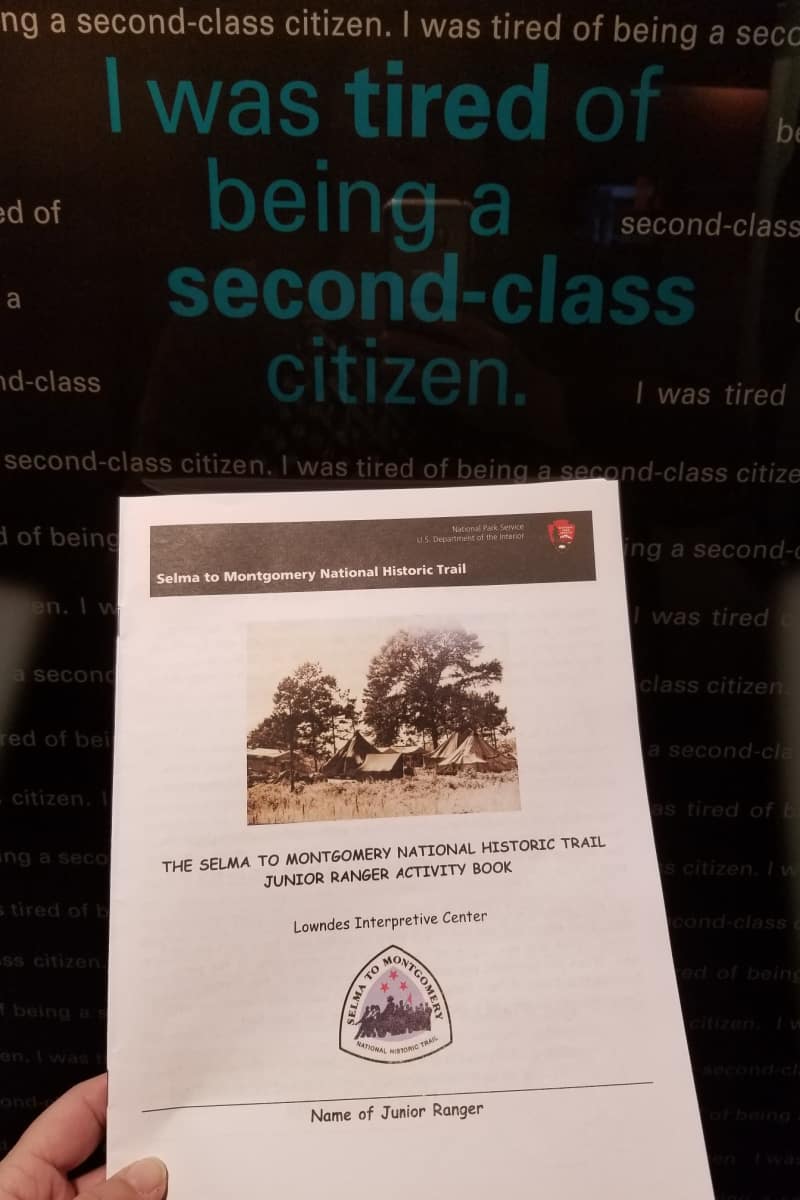
Junior Ranger Program
The Junior Ranger program is great for all ages. We do them in every park we visit. The Selma to Montgomery NHT program is a great way to learn more about this historic event.
You can fill out the program while visiting one of the visitor centers.
Follow the Selma to Montgomery March Route
The National Historic Trail follows the actual march route which began at Brown Chapel, A.M.E. Church in Selma, AL, located on Martin Luther King, Jr. Street. Follow the trail markers to U.S. Hwy. 80 through Lowndes County, AL. Continue on U.S. Hwy. 80 to Montgomery concluding at the Alabama State Capitol in Montgomery, AL, located on Dexter Avenue.
There are road signs along the route showing where to stop and specific historic sites along the way.
Edmund Pettus Bridge
You can walk across the Edmund Pettus Bridge and feel the history of the area.
The Edmund Pettus Bridge spans the Alabama River and was named after Edmund Winston Pettus, who was a Confederate general and US Senator.
John Lewis and Hosea Williams attempted to march across the bridge on March 7, 1965 along with other Civil Rights activists.
They were met by a violent attack from state troopers which became known as "Bloody Sunday". This moment was a turning point in the civil rights movement.
Visitors can walk and drive across the bridge. There are interpretive panels and exhibits along the bridge.
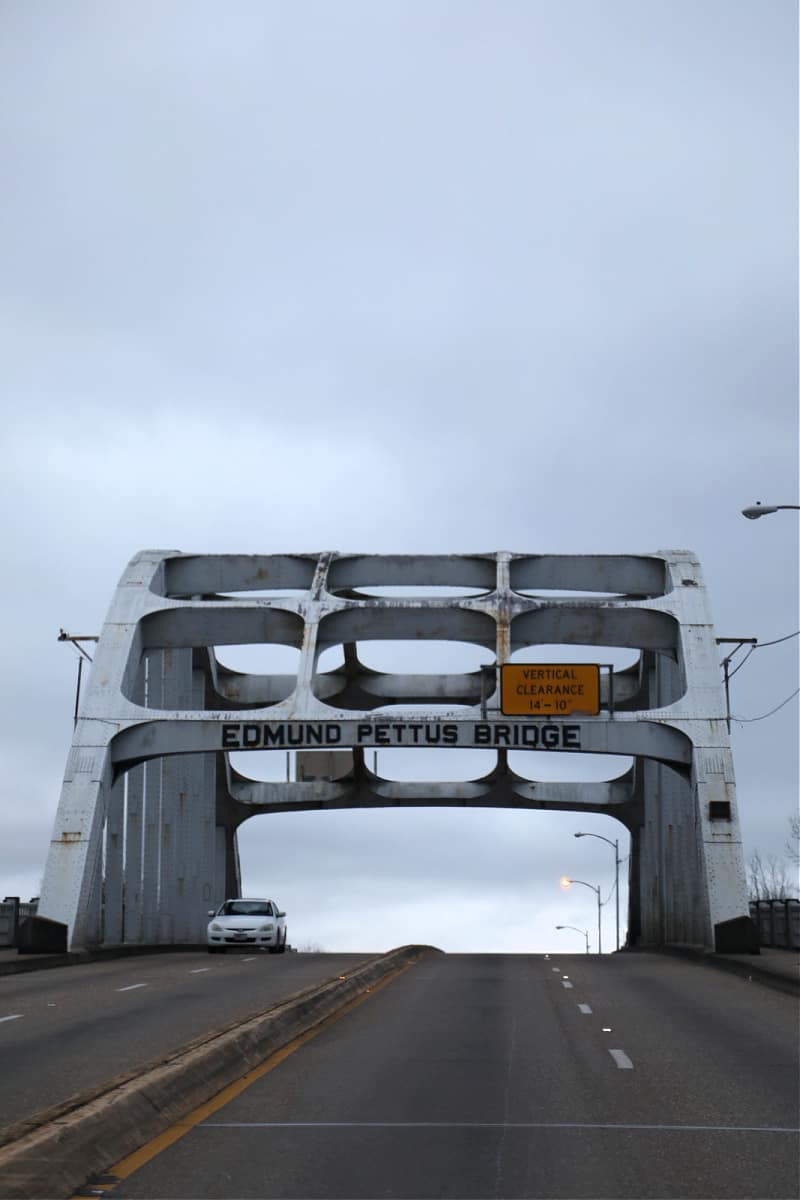
Hiking in Selma to Montgomery NHT
Always carry the 10 essentials for outdoor survival when exploring.
How to beat the crowds in Selma to Montgomery NHT?
We did not experience any crowds during our visit.
Where to stay when visiting Selma to Montgomery NHT
Hotels and Vacation rentals in Selma, Alabama
St. James Hotel Selma - take advantage of a terrace, dry cleaning/laundry services, and a bar. Be sure to enjoy a meal at Sterling Restaurant & Bar, the onsite restaurant. Stay connected with free in-room Wi-Fi, and guests can find other amenities such as a business center.
Hampton Inn Selma - take advantage of dry cleaning/laundry services, a bar, and a gym. For some rest and relaxation, visit the hot tub. Stay connected with free in-room Wi-Fi, and guests can find other amenities such as a business center.
Holiday Inn Express Selma - Free breakfast buffet, dry cleaning/laundry services, and a gym are just a few of the amenities provided at Holiday Inn Express Selma, an IHG Hotel. Stay connected with free in-room Wi-Fi, and guests can find other amenities such as a business center.
Hotels and Vacation rentals in Montgomery, Alabama
Doubletree by Hilton Hotel Montgomery Downtown - look forward to a terrace, a garden, and dry cleaning/laundry services at Doubletree by Hilton Hotel Montgomery Downtown. Free in-room Wi-Fi is available to all guests, along with a bar and a 24-hour gym.
Hilton Garden Inn Montgomery East - look forward to dry cleaning/laundry services, a bar, and a 24-hour gym at Hilton Garden Inn Montgomery East. Free Wi-Fi in public areas, with speed of 50+ Mbps, is available to all guests, along with a business center and a restaurant.
Hampton Inn & Suites Montgomery - free full breakfast, shopping on site, and mini golf. In addition to dry cleaning/laundry services and a 24-hour gym, guests can connect to free in-room Wi-Fi.
Courtyard by Marriott Montgomery - A grocery/convenience store, a coffee shop/café, and dry cleaning/laundry services are just a few of the amenities provided at Courtyard by Marriott Montgomery Prattville. The onsite bistro, The Bistro, features American cuisine. In addition to a gym and a business center, guests can connect to free in-room Wi-Fi.
Click on the map below to see additional vacation rental and hotel options:
Camping
Can visitors camp along the trail?
There are no designated National Park Campgrounds along the trail. There are nearby campsites and parks that allow camping.

For a fun adventure check out Escape Campervans. These campervans have built in beds, kitchen area with refrigerators, and more. You can have them fully set up with kitchen supplies, bedding, and other fun extras. They are painted with epic designs you can't miss!
Escape Campervans has offices in Vancouver, Seattle, Portland, San Francisco, Las Vegas, Los Angeles, Phoenix, Salt Lake City, Denver, New York, and Orlando
Frequently Asked Questions
What historic sites are along the trail?
Historic sites along the trail include many related to the Civil Rights Movement including Edmund Pettus Bridge in Selma, Brown Chapel AME Church, the National Voting Rights Museum and Institute, and the Alabama State Capitol Building in Montgomery.
How long does it take to drive the trail?
We suggest planning a day for exploring the historic trail and visiting the multiple visitor centers.
Are there guided tours available?
Yes, A few of the tours we have found include:
Montgomery/Selma Area Attraction Pass - Visit some of the best attractions in Montgomery, Selma, and Tuskegee with a 1, 2, or 5-day all-in-one attraction pass that'll act as your admission ticket to all the venues included.
Enjoy access to these attractions: Alabama State Capitol, By The River Center For Humanity, Civil Rights Memorial Center, Historic Davis Theatre Tour, The Georgine Clarke Alabama Artists Gallery, Tabernacle Baptist Church, Tuskegee History Center, Whippoorwill Vineyards, and Edmund Pettus Bridge.
You can also visit the Rosa Parks Museum, Montgomery Zoo & Mann Wildlife Learning Museum, The Hank Williams Museum, The Museum Of Alabama, The Scott And Zelda Fitzgerald Museum, The Selma-Dallas County Museum, Freedom Rides Museum, and Montgomery Museum Of Fine Arts.
Walk of Freedom Audio Tour - Immerse yourself in the history of the civil rights movement with this audio-guided tour of Montgomery. See spots linked to Martin Luther King Jr, Rosa Parks, The Freedom Riders, Marches and more.
3-Day Montgomery, AL Attraction Pass - See all Montgomery has to offer with a 3-day pass for Alabama State Capitol, Civil Rights Memorial Center, Freedom Rides Museum, Montgomery Zoo and Mann Wildlife Learning Museum, The Georgine Clarke Alabama Artists Gallery, The Hank Williams Museum, and The Scott And Zelda Fitzgerald Museum.
Is the trail open year-round?
Yes, the trail is open year-round! Each of the visitor centers and gift shops has specific hours.
Can you bike along the trail?
Yes, biking is allowed on some sections of the trail. Make sure you confirm which areas allow biking. The trail runs along a major us highway.
Check out all of the Alabama National Parks along with neighboring National Parks in Tennessee, National Parks in Georgia, National Parks in Florida, and Mississippi National Parks
I know you are scratching your head wondering, "What're the best national parks near me?" Don't worry! We've got you! See our List of National Parks by State
UNESCO World Heritage Sites in the United States
There are quite a few National Parks in the Southeast US
This park is managed by the National Park Service.





Leave a Reply